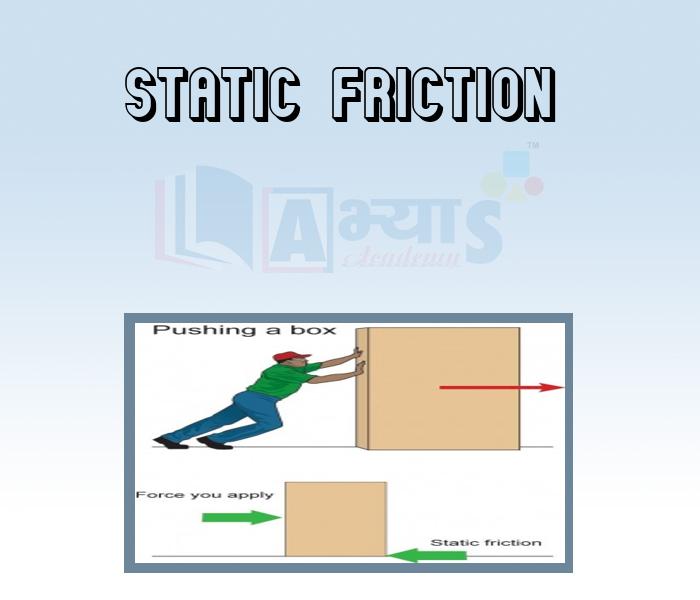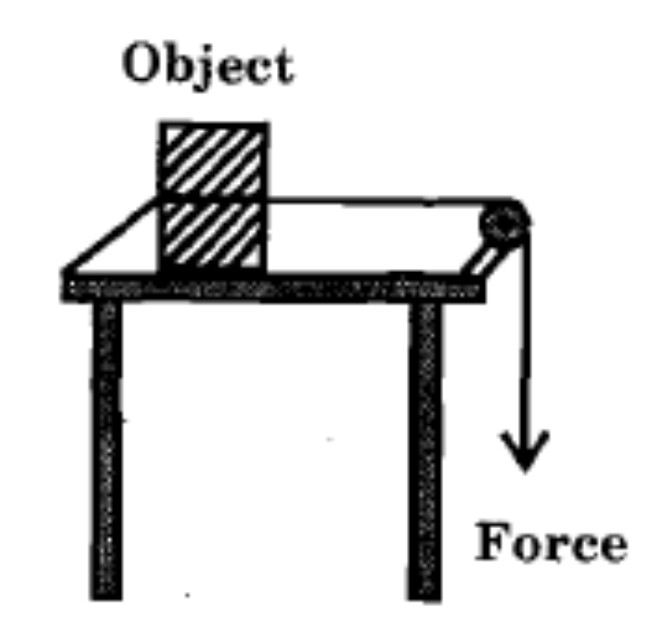Static Friction








Static Friction
The maximum frictional force present between any two objects when one object just tends to move or slip called static friction. Static friction is a kind of starting friction because an object just tends to start moving, it does not actually move. The object remains static (or stationary) in this case. We can demonstrate the static friction between a wooden block and a table top by performing an activity as follows : A wooden block (having a hook attached to its one side) is kept on the horizontal surface of a table. A spring balance is attached to the hook of wooden block (as shown in Figure 9). We pull the spring balance to the right side with a small force of our hand. This will exert a force on the wooden block. The wooden block, however, does not move because its motion is being opposed by the force of friction which acts in the opposite direction (to the left side). As we increase the pulling force applied to the wooden block (through spring balance), the friction also goes on increasing. But ultimately, when the applied force becomes a little more than the maximum frictional force, the wooden block just tends to move or slip on the surface of table. This means that the frictional force acting between the wooden block and table top has a maximum value beyond which it cannot increase. The force which we are exerting in making the wooden block just tend to move or slip is equal (but opposite) to the force of friction. In Figure 9 we can see that when the wooden block just tends to move or slip on the table top, the spring balance shows a reading of 5 N force (5 newtons force). This means that the magnitude of static friction between this wooden block and table top is of 5 newtons.
From the above discussion we conclude that the force required to overcome friction at the instant an object just tends to start moving from rest, is a measure of static friction. Static friction comes into play when we try to move a stationary object (which is at rest). Please note that in the case of static friction, the object is actually not moving or sliding over the other object, it only tends to move or slide.
A force of 5 N is required to move an object from rest. The value of static friction (f) is :
| |||
| Right Option : A | |||
| View Explanation | |||
Which of the following are correct ? (a) The maximum frictional force present between any two objects when one object just tends to move called static friction. (b) If an object just starts to move when a force of 5 Newtons is applied means that the magnitude of static friction between this wooden block and table top is of 5 Newtons. (c) Static friction comes into play when we try to move a stationary object . | |||
| Right Option : D | |||
| View Explanation | |||
Which of the following force is a Self adjusting force ? | |||
| Right Option : C | |||
| View Explanation | |||
Students / Parents Reviews [20]
In terms of methodology I want to say that institute provides expert guidence and results oriented monitering supplements by requsite study material along with regular tests which help the students to improve their education skills.The techniques of providing education helps the students to asses...

Aman Kumar Shrivastava
10thAbout Abhyas metholodology the teachers are very nice and hardworking toward students.The Centre Head Mrs Anu Sethi is also a brilliant teacher.Abhyas has taught me how to overcome problems and has always taken my doubts and suppoeted me.

Shreya Shrivastava
8thAbhyas academy is great place to learn. I have learnt a lot here they have finished my fear of not answering.It has created a habit of self studying in me.The teachers here are very supportive and helpful. Earlier my maths and science was good but now it has been much better than before.

Barkha Arora
10thThird consective year,my ward is in Abhyas with nice experience of admin and transport support.Educational standard of the institute recumbent at satisfactory level. One thing would live to bring in notice that last year study books was distributed after half of the session was over,though study ...

Ayan Ghosh
8thMy experience with Abhyas is very good. I have learnt many things here like vedic maths and reasoning also. Teachers here first take our doubts and then there are assignments to verify our weak points.

Shivam Rana
7thAbhyas is good institution and a innovative institute also. It is a good platform of beginners.Due to Abhyas,he has got knoweledge about reasoning and confidence.My son has improved his vocabulary because of Abhyas.Teacher have very friendly atmosphere also.

Manish Kumar
10thMy experience with Abhyas Academy has been very good. When I was not in Abhyas whenever teacher ask questions I could not speak it confidently but when I came in Abhyas, my speaking skills developed and now I am the first one to give the answer of teachers question.

Upmanyu Sharma
7thIt was a good experience with Abhyas Academy. I even faced problems in starting but slowly and steadily overcomed. Especially reasoning classes helped me a lot.

Cheshta
10thIt was good as the experience because as we had come here we had been improved in a such envirnment created here.Extra is taught which is beneficial for future.

Eshan Arora
8thThe experience was nice. I studied here for three years and saw a tremendous change in myself. I started liking subjects like English and SST which earlier I ran from. Extra knowledge gave me confidence to overcome competitive exams. One of the best institutes for secondary education.

Aman Kumar Shrivastava
10thMy experience was very good with Abhyas academy. I am studying here from 6th class and I am satisfied by its results in my life. I improved a lot here ahead of school syllabus.

Ayan Ghosh
8thIt has a great methodology. Students here can get analysis to their test quickly.We can learn easily through PPTs and the testing methods are good. We know that where we have to practice

Barkha Arora
10thWhen I have not joined Abhyas Academy, my skills of solving maths problems were not clear. But, after joining it, my skills have been developed and my concepts of science and SST are very well. I also came to know about other subjects such as vedic maths and reasoning.

Sharandeep Singh
7thAbhyas is an institute of high repute. Yogansh has taken admission last year. It creates abilities in child to prepare for competitive exams. Students are motivated by living prizes on basis of performance in Abhyas exams. He is satisfied with institute.

Yogansh Nyasi
7thMy experience with Abhyas academy is very good. I did not think that my every subject coming here will be so strong. The main thing is that the online tests had made me learn here more things.

Hiya Gupta
8thAbhyas Methodology is very good. It is based on according to student and each child manages accordingly to its properly. Methodology has improved the abilities of students to shine them in future.

Manish Kumar
10thOne of the best institutes to develope a child interest in studies.Provides SST and English knowledge also unlike other institutes. Teachers are co operative and friendly online tests andPPT develope practical knowledge also.

Aman Kumar Shrivastava
10thI have spent a wonderful time in Abhyas academy. It has made my reasoning more apt, English more stronger and Maths an interesting subject for me. It has given me a habbit of self studying

Yatharthi Sharma
10thAbhyas institute is one of the best coaching institute in the vicinity of Ambala Cantt area. The teachers of the institute are well experienced and very helpful in solving the problems of the students.The good thing of the institute is that it is providing extra classes for the students who are w...

Aman Kumar Shrivastava
10thAbhyas institute is one of the best coaching institute in the vicinity of Ambala cantt.The institute provides good and quality education to the students.The teachers are well experienced and are very helpful in solving the problems. The major advantages of the institute is extra classes for weak...

